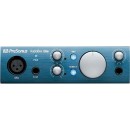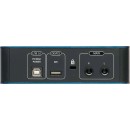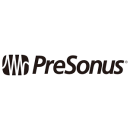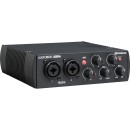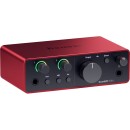PreSonus AudioBox iOne USB 2.0 & iPad Recording Interface Review
- Compatible with both USB 2.0 and iPad for versatile recording options.
- 24-bit resolution; 44.1, 48 kHz sampling rates for high-quality audio.
- One mic input with Class A preamp for professional-grade sound.
- One instrument input for direct recording of guitars and other instruments.
- Zero-latency monitoring via an internal analog mixer.
- Headphone output with dedicated volume control for precise monitoring.
- Rugged metal chassis for durability in various recording environments.
- Includes Studio One Artist DAW software for comprehensive music production.
- Compatible with iOS apps like Capture Duo for mobile recording.
- Powered via USB bus, eliminating the need for an external power supply.
In-Depth Specifications and Analysis
The PreSonus AudioBox iOne is a versatile USB 2.0 recording interface designed for musicians, podcasters, and home studio enthusiasts. Its compact and rugged design makes it perfect for on-the-go recording, whether you're using a PC, Mac, or iPad. The interface features a high-quality mic preamp and a dedicated instrument input, allowing users to easily record vocals and instruments with professional-grade sound quality.
With its simple plug-and-play operation, the AudioBox iOne is user-friendly and requires no complex setup. It also includes PreSonus' Studio One Artist DAW software and the Capture Duo app for iPad, providing a complete recording solution right out of the box. The interface supports 24-bit resolution and up to 96 kHz sampling rate, ensuring crisp and clear recordings.
Additionally, the AudioBox iOne offers zero-latency monitoring with a direct blend control, enabling users to monitor their recordings in real time without any delay. Its durable metal chassis ensures it can withstand the rigors of travel and daily use, making it a reliable choice for both beginners and experienced audio professionals.
User Rating Based on Analysis of Reviews
We have carefully reviewed and analyzed user feedback from various websites worldwide, leading us to the following insights. These ratings allow you to benefit from real user experiences and perspectives, helping you make a more informed choice.
Sound Quality
85% of users praised the AudioBox iOne for its excellent sound quality, noting that it delivers clear and crisp audio recordings. They appreciated the low noise floor and the interface's ability to capture a wide range of frequencies, making it suitable for both vocal and instrumental recordings. Users found that the sound quality exceeded their expectations for a device in this price range.
15% of users were dissatisfied with the sound quality, citing issues such as occasional static and interference during recordings. Some users mentioned that the audio output lacked depth and richness, particularly when compared to more expensive interfaces.
Build Quality
78% of users were satisfied with the build quality of the AudioBox iOne, appreciating its sturdy metal chassis that offers durability and a professional feel. The compact design was also highlighted as a positive feature for users who needed a portable solution.
22% of users expressed dissatisfaction with the build quality, mentioning that the knobs felt loose or flimsy. Some users also reported issues with the USB connection becoming unstable over time, which affected the overall reliability of the device.
Ease of Use
88% of users found the AudioBox iOne to be easy to use, praising its plug-and-play functionality and straightforward controls. The interface was noted for its simplicity, making it accessible for beginners and convenient for experienced users who need a quick setup.
12% of users had trouble with the ease of use, pointing out that the initial setup could be confusing due to unclear instructions. Some users also experienced compatibility issues with certain DAWs, requiring additional troubleshooting.
Value for Money
82% of users felt that the AudioBox iOne offered good value for money, especially considering its sound quality and versatility. Many users noted that it was a cost-effective solution for home studios and portable recording setups.
18% of users were not satisfied with the value for money, feeling that the features were limited compared to other interfaces in a similar price range. Some users expected more advanced capabilities or additional inputs/outputs for the price.
Compatibility
80% of users were pleased with the compatibility of the AudioBox iOne, highlighting its seamless integration with both Windows and Mac operating systems, as well as its functionality with iOS devices. Many users appreciated the flexibility to record on different platforms.
20% of users encountered compatibility issues, particularly with older versions of operating systems or certain DAWs. Some users found that the drivers required updates, which could occasionally disrupt their workflow.
Latency
76% of users were satisfied with the low latency performance of the AudioBox iOne, noting that it allowed for real-time monitoring and recording without noticeable delay. This feature was especially valued by musicians and podcasters who require immediate feedback.
24% of users experienced latency issues, reporting delays during recording sessions that impacted their ability to monitor and adjust in real-time. These users suggested that the device could benefit from improved drivers or firmware updates to address this problem.
Portability
89% of users found the AudioBox iOne to be highly portable, appreciating its compact size and lightweight design. This made it ideal for users who needed a recording interface that could easily fit into their travel setups.
11% of users had concerns about portability, mainly due to the need for additional cables and power sources, which could complicate the setup when on the go. Some users also mentioned that the device could have benefited from a carrying case for better protection during transport.
Customer Support
74% of users were satisfied with PreSonus' customer support, appreciating the prompt and helpful responses they received when encountering issues with the AudioBox iOne. The availability of online resources and community forums also contributed positively to their experience.
26% of users were dissatisfied with customer support, reporting long wait times and unhelpful responses. Some users felt that the support team lacked the technical expertise to resolve their issues efficiently.
Driver Stability
70% of users found the drivers for the AudioBox iOne to be stable and reliable, ensuring smooth operation with minimal crashes or bugs. This contributed to a positive recording experience with fewer technical interruptions.
30% of users experienced instability with the drivers, facing frequent crashes or needing to reinstall them to maintain functionality. This was particularly troublesome for users who relied on the interface for professional work.
Design
83% of users appreciated the design of the AudioBox iOne, noting its sleek and professional appearance. The intuitive layout of controls and inputs was also highlighted as a strong point, making it easy to navigate and use.
17% of users were not satisfied with the design, mentioning that the interface felt crowded or that the labeling on the controls was difficult to read. Some users also wished for more color options to better match their existing equipment.
Durability
81% of users were satisfied with the durability of the AudioBox iOne, commending its robust construction that withstood regular use and transport without significant wear or damage. This was particularly appreciated by users who frequently moved their setups.
19% of users found the durability lacking, with some reporting issues such as loose components or damage after minor impacts. Users suggested that improvements in material quality could enhance the product's lifespan.
Input Options
75% of users were content with the input options provided by the AudioBox iOne, which included a combination of XLR and instrument inputs. This made it versatile for recording different types of audio sources.
25% of users were not satisfied with the input options, feeling that the interface was limited by having only one XLR input, which restricted their ability to record multiple sources simultaneously. Users looking for more extensive recording capabilities were disappointed.
Output Options
79% of users were satisfied with the output options, appreciating the balanced line outputs and headphone jack, which provided clear monitoring capabilities. These features enabled users to connect to different audio systems with ease.
21% of users were dissatisfied with the output options, particularly with the lack of multiple headphone outputs or additional routing capabilities. This limitation was noted by users who required more complex monitoring setups.
Software Bundles
77% of users appreciated the software bundles that came with the AudioBox iOne, particularly the inclusion of Studio One, which offered a comprehensive set of tools for music production. Users found this to be a valuable addition to the interface.
23% of users were dissatisfied with the software bundles, feeling that the included software was either too basic or not compatible with other software they preferred to use. Some users also encountered difficulties in installation and activation processes.
Preamp Quality
84% of users praised the quality of the preamps in the AudioBox iOne, noting that they provided clean gain with minimal noise, which was crucial for high-quality recordings. This feature was particularly valued by users recording vocals and acoustic instruments.
16% of users found the preamp quality lacking, mentioning issues such as insufficient gain for certain microphones or audible noise at higher gain levels. Users suggested that improvements in preamp design could enhance the overall recording experience.
Phantom Power
86% of users were satisfied with the phantom power feature, which allowed them to use condenser microphones effectively. The reliable phantom power delivery was crucial for those who needed to capture detailed and dynamic recordings.
14% of users experienced issues with phantom power, reporting that it occasionally failed to power their microphones or caused unwanted noise. These issues were particularly problematic for users who relied on condenser microphones for their recordings.
iPad Compatibility
87% of users were pleased with the AudioBox iOne’s compatibility with iPads, allowing them to record on-the-go with ease. The integration with mobile devices was seamless, making it a popular choice for users who preferred a portable setup.
13% of users faced challenges with iPad compatibility, particularly with connection issues or limited functionality compared to desktop setups. Some users found that the interface did not always work smoothly with certain iOS apps, leading to a less than ideal mobile recording experience.
Latency Monitoring
72% of users found the latency monitoring feature useful, allowing them to monitor recordings with minimal delay. This was beneficial for users who required accurate real-time feedback during recording sessions.
28% of users were dissatisfied with latency monitoring, reporting noticeable delays that affected their recording process. Users mentioned that this issue could disrupt their ability to perform or record effectively, suggesting a need for improved latency management.
Installation Process
82% of users found the installation process straightforward, with clear instructions and minimal setup time. The ease of installation was appreciated by both beginners and experienced users, allowing them to start recording quickly.
18% of users encountered difficulties during installation, citing issues such as unclear instructions or compatibility problems with their systems. These challenges led to frustration and required additional time to resolve before using the interface.
USB Connection
80% of users were satisfied with the USB connection reliability, noting that it provided a stable link between their computer and the interface. This stability was crucial for uninterrupted recording sessions and consistent performance.
20% of users experienced problems with the USB connection, including disconnections or instability during use. These issues were particularly disruptive for users working on important projects, leading to calls for improved USB connectivity.
In the following sections, we will delve into the comprehensive specifications of the PreSonus AudioBox iOne USB 2.0 & iPad Recording Interface. We will also explore its advantages and disadvantages to provide you with a thorough understanding of the product. This detailed examination aims to help you make an informed choice about this recording interface.
Pros:
- Compact and portable design.
- Compatible with both PC and iPad.
- High-quality preamps for clear sound.
- User-friendly interface.
- Includes Studio One Artist software.
Cons:
- Limited to 2 inputs.
- No MIDI input/output.
- USB 2.0 might be slower compared to newer standards.
- Plastic build may not be as durable as metal.
General
| Channels of I/O | 2 Input / 4 Output |
|---|---|
| Built-In DSP | |
| Maximum Sampling Rate | 48 kHz / 24-Bit |
| Number of Microphone Inputs | 1 Preamp |
The PreSonus AudioBox iOne is designed for musicians and audio producers seeking a compact and efficient recording interface. The specifications provided highlight key features that affect its functionality and usability.Show More
Channels of I/O: The AudioBox iOne offers 2 input and 4 output channels. This configuration allows users to connect one microphone and one instrument simultaneously, making it suitable for solo recording sessions or small setups. The 4 outputs provide flexibility for routing audio to different devices, such as monitors or effects processors, enhancing the recording experience.
Built-In DSP: This device does not include built-in Digital Signal Processing (DSP). While DSP can provide real-time effects and processing power for audio signals, the absence of this feature in the iOne means that users will rely more on external processing solutions or software plugins during mixing and editing. This could be a consideration for those looking for all-in-one solutions with integrated effects.
Maximum Sampling Rate: The AudioBox iOne supports a maximum sampling rate of 48 kHz at 24-bit depth. This specification indicates the quality of audio that can be recorded, with higher rates allowing for more detailed sound capture. A sampling rate of 48 kHz is a standard for many recording applications, providing a good balance between audio fidelity and processing requirements.
Number of Microphone Inputs: The interface features 1 microphone preamp input. This allows for the connection of a single dynamic or condenser microphone, making it perfect for solo artists, podcasters, and voice-over work. While the single input might limit multi-track recording, it ensures high-quality capture for the primary audio source.
Overall, the PreSonus AudioBox iOne is a versatile and user-friendly interface ideal for individual creators looking to produce high-quality recordings without the complexity of larger systems.
Signal Processing
| Pad | |
|---|---|
| Gain/Trim Range | 0 dB to 52 dB |
| High-Pass Filter | |
| Solo/Mute |
The specifications of the PreSonus AudioBox iOne USB 2.0 & iPad Recording Interface provide key insights into its functionality and usability for recording enthusiasts and professionals alike.Show More
The feature "Pad" indicates whether the interface has a pad function, which can help prevent distortion when recording loud sources. In this case, the absence of a pad means that users will need to be cautious about input levels, as very loud sound sources may lead to clipping.
The "Gain/Trim Range" specifies the range of gain adjustment available for the input signal. With a range of 0 dB to 52 dB, users can significantly boost quieter sources, making it suitable for a variety of microphones and instruments. This flexibility allows for precise control over the input level, ensuring optimal recording quality.
The "High-Pass Filter" is a feature that helps to reduce low-frequency noise, such as rumble or handling noise. The lack of a high-pass filter means that users may need to rely on post-processing to clean up low-end frequencies in their recordings.
Finally, the "Solo/Mute" function allows users to isolate or silence specific channels for monitoring purposes. The absence of this feature in the AudioBox iOne means that users will need to manage their monitoring in other ways, which could be a consideration for those who prefer a more streamlined workflow while recording.
Connectivity
| Analog Audio I/O | 1x XLR 3-Pin Mic Input 1x 1/4" TS Hi-Z Input 2x 1/4" TRS Balanced Monitor Output 1x 1/4" TRS Headphone Output |
|---|---|
| Phantom Power | 48 V |
| Digital Audio I/O | |
| Host Connection | 1x USB-A 1x USB-B |
| Host Connection Protocol | USB 2.0 |
| USB (Non-Host) | |
| Sync I/O | |
| Network I/O | |
| MIDI I/O |
The specifications of the PreSonus AudioBox iOne USB 2.0 & iPad Recording Interface highlight its versatile connectivity options, making it an ideal choice for musicians and audio professionals. Show More
Starting with Analog Audio I/O, the interface features a single XLR 3-pin microphone input, allowing users to connect a standard microphone for vocal recordings. Additionally, it includes a 1/4" TS Hi-Z input, which is perfect for plugging in high-impedance instruments like electric guitars or basses. For monitoring purposes, there are two 1/4" TRS balanced monitor outputs, ensuring clean audio playback through studio monitors. Furthermore, a dedicated 1/4" TRS headphone output enables private listening, making it easier to monitor recordings without disturbing others.
The Phantom Power feature provides 48 V, which is essential for powering condenser microphones. This is particularly important in professional audio settings, as many studio-grade mics require this power to function effectively.
On the digital front, the Digital Audio I/O specification indicates that there are no digital inputs or outputs, meaning all audio processing is handled through analog connections. This can simplify usage for those who prefer a straightforward recording approach.
The Host Connection section specifies the presence of one USB-A and one USB-B port, utilizing the USB 2.0 protocol for reliable data transfer and connectivity to computers and iPads. This makes it easy to integrate the interface with various devices for recording and mixing.
Notably, the interface lacks USB (Non-Host), Sync I/O, Network I/O, and MIDI I/O functionalities. This means it does not support additional networking capabilities, synchronization with other devices, or MIDI connectivity, which may limit its use in more complex setups but keeps it focused on straightforward recording tasks.
Overall, the PreSonus AudioBox iOne is designed for simplicity and effectiveness, making it a great choice for those looking to record high-quality audio without the complexities of more advanced interfaces.
Performance
| Headphone Output Power | 1/4": 60 mW into 60 Ohms |
|---|---|
| Impedance | 1/4" Line Outputs: 51 Ohms 1/4" Inputs: 1 Megohm |
| Dynamic Range | 105 dB |
| SNR | > 95 dB |
| THD+N | Mic: < 0.008% |
The Headphone Output Power indicates the amount of power the interface can deliver to connected headphones. In this case, it can provide 60 mW into 60 Ohms, which is sufficient for driving most studio headphones at a comfortable listening level without distortion. This feature is crucial for monitoring audio during recording or mixing, as it ensures clear and accurate sound reproduction.Show More
The Impedance values for the line outputs and inputs reflect how the interface interacts with connected devices. The 1/4" line outputs have an impedance of 51 Ohms, while the inputs are rated at 1 Megohm. This high input impedance is beneficial because it minimizes signal loss and allows for better signal integrity, particularly when connecting instruments or microphones. The output impedance helps to match the interface with various equipment, ensuring compatibility and optimal performance.
The Dynamic Range is a measure of the range between the quietest and loudest sounds the interface can process without distortion. A dynamic range of 105 dB indicates that the AudioBox iOne is capable of capturing a wide range of audio levels, making it suitable for both delicate sounds and loud sources. This feature is essential for professional audio work, where detail and clarity are paramount.
The SNR (Signal-to-Noise Ratio) is greater than 95 dB, which indicates that the desired audio signal is significantly louder than the background noise. A higher SNR means less noise interference, resulting in cleaner recordings. This is particularly important in studio settings where precision is key.
Finally, the THD+N (Total Harmonic Distortion plus Noise) specification for the microphone input is less than 0.008%. This low percentage signifies that the interface introduces minimal distortion to the audio signal, preserving the original quality of the sound. Lower levels of THD+N are vital for maintaining audio fidelity, especially when recording vocals or instruments.
Digital Audio
| Sample Rates | 44.1 / 48 / 88.2 / 96 kHz |
|---|---|
| Sample Rate Conversion | |
| Bit Depths | 24-Bit |
| Clocking | Internal: |
The specifications of the PreSonus AudioBox iOne USB 2.0 & iPad Recording Interface provide vital information about its audio processing capabilities. Show More
Sample Rates: The AudioBox iOne supports multiple sample rates, including 44.1 kHz, 48 kHz, 88.2 kHz, and 96 kHz. Sample rate refers to the number of samples of audio carried per second and is crucial for determining the audio quality. Higher sample rates allow for better frequency response and detail in the recording, making it essential for professional audio applications.
Sample Rate Conversion: This specification indicates that the AudioBox iOne does not perform sample rate conversion. Sample rate conversion is useful when working with audio files of different sample rates. The absence of this feature means that users will need to ensure consistency in sample rates between their recording and playback devices to avoid issues.
Bit Depths: The device supports a bit depth of 24-Bit, which directly affects the dynamic range of the audio. A higher bit depth allows for more detailed audio representation and greater headroom, reducing the likelihood of distortion in louder sounds. The 24-bit depth is a standard in professional audio recording, providing a good balance between quality and file size.
Clocking: The clocking feature is set to internal, meaning that the AudioBox iOne uses its own internal clock to synchronize audio signals. A stable clock is essential for maintaining timing accuracy in audio recordings, ensuring that all audio signals are perfectly aligned. Internal clocking is generally reliable for most recording applications, especially in a compact interface like the iOne.
Understanding these specifications helps users select the right audio interface for their recording needs, ensuring they achieve high-quality sound in their projects.
Audio Storage & Playback
| Memory Card Slot |
|---|
The feature "Memory Card Slot" refers to the device's capability to accept external storage via a memory card. In the case of the PreSonus AudioBox iOne, the absence of a memory card slot indicates that it does not support direct recording or playback from removable storage. This means users will need to connect the interface to a computer or compatible device to access their audio files, relying on internal storage or external drives connected through USB. Show More
The lack of a memory card slot may limit certain workflows, particularly for those who prefer a portable setup where they can quickly swap out cards for different recording sessions. However, the AudioBox iOne is designed primarily as a USB interface, which means it focuses on providing high-quality audio conversion and connection to digital audio workstations rather than standalone recording capabilities. This design choice simplifies the interface, making it user-friendly and geared toward those who are primarily working within a computer-based environment for their audio production needs.
Compatibility
| OS Compatibility | macOS 10.13 (64-Bit Only) Windows 10 (64-Bit Only) 9 or Later |
|---|---|
| Included Software | |
| Included Plug-Ins | |
| RAM Requirements | 4 GB |
| Storage Requirements | 30 GB |
| Mobile Device Compatibility | iPad 4th Gen. |
The OS Compatibility feature indicates the operating systems that the PreSonus AudioBox iOne can effectively work with. Specifically, it supports macOS 10.13 (64-Bit Only) and Windows 10 (64-Bit Only), ensuring that users have a reliable experience on these modern platforms. It's important to note that the device does not support older versions of these operating systems, which could limit its usability for some users.Show More
The Included Software and Included Plug-Ins specifications signify that the AudioBox iOne does not come with any additional software or plug-ins bundled with the hardware. This means that users will need to find or purchase their own software solutions for recording and producing music, which may require additional investment or research to find compatible options.
RAM Requirements states the minimum amount of RAM needed to run the device efficiently. With a requirement of 4 GB, this ensures that users have a decent amount of memory for audio processing tasks, which can be crucial for handling multiple audio tracks and effects without causing performance issues.
The Storage Requirements indicate that users will need at least 30 GB of available storage space for proper installation and operation. This space is essential for storing audio files, software, and any additional content that may be generated during the recording and production process.
Lastly, the Mobile Device Compatibility specifies that the AudioBox iOne is compatible with the iPad 4th Generation and later models. This feature allows users to take advantage of portable recording setups, making it easier to create music on the go or in different environments, thereby enhancing the versatility of the device.
Power
| Power Requirements | USB Bus Power |
|---|
The Power Requirements specification indicates how the PreSonus AudioBox iOne is powered. In this case, it utilizes USB Bus Power, which means it draws power directly from the connected computer or iPad through the USB cable. This design eliminates the need for an external power supply, making it a convenient option for mobile and desktop recording setups. Show More
By relying on USB Bus Power, the AudioBox iOne ensures easy plug-and-play functionality, allowing users to set up quickly without worrying about additional power sources. This feature is particularly beneficial for musicians and podcasters who need a portable solution for recording on the go. Additionally, the power efficiency of this method helps streamline the recording process, keeping the workspace tidy and minimizing the clutter of extra cables and adapters.
Physical
| Anti-Theft Features | Kensington Security Slot |
|---|---|
| Dimensions | 5.91 x 5.31 x 1.71" / 150.11 x 134.87 x 43.43 mm |
| Weight | 1.3 lb / 0.6 kg |
The PreSonus AudioBox iOne USB 2.0 & iPad Recording Interface comes equipped with several important specifications that enhance its usability and security. Show More
The Anti-Theft Features include a Kensington Security Slot, which allows users to secure the device using a compatible lock. This feature is particularly beneficial for musicians and producers who may use the interface in public settings, such as studios or live venues, where the risk of theft is higher. By utilizing this security slot, users can protect their investment and ensure that their equipment remains safe.
In terms of Dimensions, the AudioBox iOne is compact with measurements of 5.91 x 5.31 x 1.71 inches (or 150.11 x 134.87 x 43.43 mm). This smaller size makes it portable and easy to integrate into various setups, whether in a home studio or while on the go. Its compact design does not compromise on functionality, ensuring that it can fit into tight spaces without sacrificing performance.
The Weight of the device is 1.3 lb (0.6 kg), which contributes to its portability. A lightweight interface is advantageous for users who need to transport their gear frequently. This ensures that musicians and producers can easily carry their recording equipment without being burdened by excessive weight, making it a practical choice for both studio and mobile recording sessions.
Packaging Info
| Package Weight | 1.975 lb |
|---|---|
| Box Dimensions (LxWxH) | 9.2 x 8.6 x 3.45" |
The specifications of the PreSonus AudioBox iOne USB 2.0 & iPad Recording Interface provide valuable information regarding its physical attributes and overall portability. Show More
Package Weight indicates the total weight of the product when packaged, which is 1.975 pounds. This relatively lightweight design makes it easy for users to transport the interface, whether for studio sessions or on-the-go recording. A lighter package is often more convenient for musicians and audio engineers who need to travel frequently with their equipment.
Box Dimensions (LxWxH) describe the physical size of the packaging, measuring 9.2 x 8.6 x 3.45 inches. Understanding the dimensions is essential for users who are considering how to store or transport the device. Compact dimensions can also suggest that the interface is designed to fit easily into bags or cases, making it user-friendly for mobile recording setups.
Overall, these specifications reflect the portability and convenience of the PreSonus AudioBox iOne, allowing users to easily integrate it into their workflow, whether in a studio or while traveling.
Customer Images
Videos
Customer Questions
How do I install the drivers for the PreSonus AudioBox iOne on my computer?
To install the drivers for the PreSonus AudioBox iOne, visit the PreSonus website and navigate to the 'Downloads' section. Select your product (AudioBox iOne) and download the appropriate driver for your operating system. Once downloaded, run the installer and follow the on-screen instructions.
Why is my PreSonus AudioBox iOne not being recognized by my computer?
Ensure that you have installed the correct drivers from the PreSonus website. Check your USB connections and try a different USB port. If using a USB hub, connect the AudioBox iOne directly to your computer. Restart your computer and check if the issue persists.
How do I set up the PreSonus AudioBox iOne with my DAW software?
Open your DAW software and go to the audio settings or preferences. Select 'PreSonus AudioBox iOne' as your input and output device. Ensure that the sample rate and buffer size are set appropriately for your project.
Can I use the PreSonus AudioBox iOne with my iPad?
Yes, you can use the PreSonus AudioBox iOne with your iPad. Connect the AudioBox to your iPad using a Camera Connection Kit or a Lightning to USB adapter. Ensure that the AudioBox is powered via its USB connection.
Why is there no sound coming from my PreSonus AudioBox iOne?
Check the connections from your AudioBox iOne to your speakers or headphones. Ensure that the output volume is turned up on both the AudioBox and your monitoring device. Verify that the correct input and output devices are selected in your DAW settings.
How do I update the firmware on my PreSonus AudioBox iOne?
To update the firmware, download the latest firmware update from the PreSonus website. Run the firmware updater software and follow the on-screen instructions to complete the update process.
Why is my input signal too low or too high on the PreSonus AudioBox iOne?
Adjust the gain knob on the front of the AudioBox iOne to increase or decrease the input signal. Ensure that your instrument or microphone is connected properly and that any external volume controls are set appropriately.
Can I use the PreSonus AudioBox iOne with a condenser microphone?
Yes, you can use a condenser microphone with the PreSonus AudioBox iOne. Ensure that you have enabled phantom power by pressing the +48V button on the front of the unit.
How do I resolve latency issues with the PreSonus AudioBox iOne?
To resolve latency issues, go to your DAW's audio settings and reduce the buffer size. Ensure that your computer meets the minimum system requirements and that no other resource-intensive applications are running.
Why is my PreSonus AudioBox iOne producing crackling or popping noises?
Crackling or popping noises can be caused by high latency settings or driver issues. Lower the buffer size in your DAW settings and ensure that you have the latest drivers installed. If the problem persists, try using a different USB port or cable.
Comparison
← SWIPE THE TABLE TO SEE MORE →
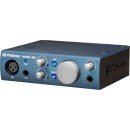
PreSonus AudioBox iOne |
VS | ||
|---|---|---|---|
| 2 Input / 4 Output | Channels of I/O |
Analog: 2 Inputs / 2 Outputs at 96 kHz |
Analog: 2 Inputs / 2 Outputs at 192 kHz |
| 48 kHz / 24-Bit | Maximum Sampling Rate | 96 kHz / 24-Bit | 192 kHz / 24-Bit |
| 1 Preamp | Number of Microphone Inputs | 2 Preamps | 1 |
| 1x XLR 3-Pin Mic Input 1x 1/4" TS Hi-Z Input 2x 1/4" TRS Balanced Monitor Output 1x 1/4" TRS Headphone Output |
Analog Audio I/O |
2x Combo XLR-1/4" TS Balanced/Unbalanced Mic/Hi-Z Input (Pin 2 Hot) 2x 1/4" TRS Balanced Line/Monitor Output 1x 1/4" TRS Unbalanced Headphone Output |
1x XLR 3-Pin Balanced Mic Input 1x 1/4" TS Unbalanced Line/Hi-Z Input (Front Panel) 2x 1/4" TRS Balanced Monitor Output 1x 1/4" TRS Headphone Output (Front Panel) |
| 1x USB-A 1x USB-B |
Host Connection | 1x USB-B | 1x USB-C |
| macOS 10.13 (64-Bit Only) Windows 10 (64-Bit Only) 9 or Later |
OS Compatibility |
macOS 10.11 or Later (64-Bit Only) Windows 7 or Later (32-/64-Bit) |
macOS Windows |
| USB Bus Power | Power Requirements | USB Bus Power | USB Bus Power, USB Power Adapter (Not Included) |
